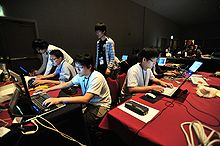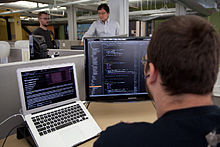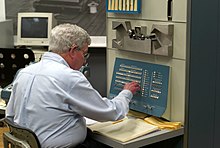Hacker
![]()
The title of this article is ambiguous. For other meanings, see Hacker (disambiguation).
Hacker (also pronounced [ˈhɛkɐ]) has several meanings in the technical field. In its original usage, the term refers to tinkerers in the context of a playful self-referential dedication in dealing with technology and a special sense of creativity and originality (hack value). In everyday language and especially in reporting, the term is often used as a synonym for someone who illegally penetrates computer systems.
Wau Holland, a founder of the Chaos Computer Club, coined the phrase: "A hacker is someone who tries to find a way to make toast with a coffee machine". According to this, this can also be about experimentation, trying to explore the limits of what is possible. The execution of the activities is called hacking; the result is a hack.
In the 1980s, the scene emerged from the field of data security. It has shaped the public understanding of the term hacker like no other scene. Parts of this scene see their intention in pointing out and eliminating security gaps and attribute a positive appeal to the term. In the public perception, it has been used more frequently since 1983 to refer to people who unauthorizedly circumvent security barriers and exploit such gaps (see also: cracker), whereby "hacker" can be distinguished from "script kiddie": a hacker has deep basic knowledge, a script kiddie does not. Since 1988, the female form, haeckse, has been coined within the Chaos Computer Club.
The other scenes are not directly related to data security and have already emerged since the late 1950s. Their most momentous legacy includes the Internet (since 1969) and the development of the first personal computers (since 1975 with the creation of the Homebrew Computer Club). Likewise, the Free Software movement (since 1984 with the creation of the GNU project) and the Open Source movement (since 1998) emerged from it. Accordingly, the term has strong positive and negative connotations.

Measurement on a circuit board with a multimeter or oscilloscope, typical activity in hardware hacking.

A team of computer security hackers at DEFCON 17.

Programmers at work. The origins of hacker culture lie partly in the software-side customization of computers.
Overview
Use of the term since the end of the 1950s until today
In hacker jargon, the field of activity of a hacker extends to any field of technology. As an example, someone in the field of astronomy may also be a hacker. The term has existed since the late 1950s and in an overarching sense encompasses technology enthusiasts who like to experiment, especially (but not only) in the field of information and communication technology. Unlike usual users of technical systems, who prefer to just learn how to use them, they enjoy examining the systems in detail. With their expertise, they often use devices of any kind outside their normal purpose or use.
Since September 1983, "hacker" has been used in public perception mostly in a pejorative way in the context of computer crime. It thus acquired a bad connotation both in media reporting and in politics and justice, where it has since been used to describe computer users who are involved in breaking into other people's computers and networks. In the ensuing years to the present day, it has also been associated with various forms of cybercrime, from phishing and in some cases to cyberterrorism. The German government, meanwhile, hopes hackers will actively help create surveillance mechanisms, but critics see this as a "highly questionable initiative under constitutional law." The scene of hackers, represented in Germany by the Chaos Computer Club, is itself one of the biggest critics both of surveillance and with regard to other actions that violate their ethical principles (see demarcation to the term "cracker").
The term has a predominantly positive connotation in the context of the GNU project, which has existed since January 1984, the free software movement, and the open source movement that arose 14 years later. The Free Hardware movement is also part of this. One characteristic of a hacker is not the activity itself, but the way it is done. Someone who develops for an open source project, for example, is not automatically a hacker, but the hacker community is closely linked to these movements. Journalist Steven Levy first reported on their innovative influence in the creation of the Internet and the development of the personal computer in his 1984 book Hackers - Heroes of the Computer Revolution. Hackers help improve technical infrastructures, processes and devices, including by pointing out or correcting security vulnerabilities. Parts of the security community use their expertise to advocate both freedom of information, in terms of public data, and protection of personal data, or privacy. In the latter context, they are concerned, for example, with general data economy, the right to informational self-determination and other aspects of data protection. As an example, one of the scene's spokespersons - Constanze Kurz - was awarded the Theodor Heuss Medal in this context in 2013 for her exemplary democratic behavior; in 2014, she was honored with Germany's Digital Minds award, which goes to those who are driving digital development in Germany with their ideas and projects. The security scene actively educates on topics such as Internet use, encryption, censorship, social network risks, data retention and related issues. It is closely linked to the civil rights movement Freiheit statt Angst (Freedom not Fear) and prepares expert opinions for the Federal Constitutional Court or participates in hearings of the Federal Government.
For more information, see the sections on "Self-image" and "Public perception".
Distinction from the term "cracker
A hacker ethic has existed since the beginning of the hacker culture that formed at US academic institutions in the 1960s and 1970s. It was first documented in writing in Steven Levy's 1984 book Hackers. In it, Levy formulates his impression of the values of the early hacker scene at MIT. At the end of the 1980s, his formulation was adopted by the Chaos Computer Club and expanded to include the concerns of the security scene. A distinction from actions beyond the hacker ethic is also applied beyond the hacker community, for example, in official expert organizations. For example, the Federal Office for Information Security writes "Malicious hackers are called crackers", where malicious means a destructive action that causes damage. The division between "well-intentioned hackers" and "malicious crackers" has been an attempt by the hacker community since the early 1990s to counteract the damage to its image caused by bad press. In contrast, this attempt hardly receives any attention in the media and in politics and is viewed critically even within the security scene, as there is no clear dividing line between "good" and "evil".
Furthermore, the meaning of "cracker" is not uniform and therefore depends heavily on the context: When used in conjunction with a CrackMe, the word refers to an intellectual-level sport that is neither unlawful nor destructive. In particular, academic hacker culture has wanted to distance itself completely from the security scene since June 1990. This is a scene that originally emerged from academia, which does not mean that hacking was an academic field of study at the time. According to their definition, all hackers who focus their activities on circumventing security mechanisms, regardless of their motivation, are not called hackers, but crackers. The Jargon File clarifies the self-image of the academic hacker culture. Since July 1993, it has formulated a hacker ethic that includes a point about such activities that remains controversial to this day: They write that it is morally okay for crackers to break into a system as long as it is solely for its investigation and nothing is spied on or damaged in the process. On this point, they agree with the security community, who, however, call such people hackers.
For more information on this, see the "Crackers" and "Hacker Ethics" sections.
Hacking scenes
- At the "Tech Model Railroad Club of MIT", hacker stands for someone who uses their ingenuity to achieve a clever result (a hack). This scene has existed since the late 1950s.
- Hacker-related programming first appeared at MIT in the early 1960s and almost completely overlaps with the free software and open source movements in the present.
- Hardware hackers appear as widely differing subforms in each scene, such as within the Free Hardware movement. Today's Maker subculture is closely related to the hardware hackers.
- Within computer security, the challenge of hacking is seen in overcoming security mechanisms and thus being able to identify vulnerabilities. This scene emerged in the 1980s from phreaking, a scene that has existed since the 1970s and deals with the manipulation of telephone connections. Related in theme is the software cracker scene, which emerged in the early 1980s from the 1970s home computer scene. The demoscene emerged from this scene at the end of the 1990s.
For more information on this, see the sections "Origin at MIT and TMRC", "Software Development", "Hardware Hackers", and "Security Scene".
The main difference between the scenes is their largely separate historical origins and development, which is why they are each characterised by their own view of hacker concepts, tradition and folklore. Scenes that emphasize circumventing security mechanisms have many inconsistent viewpoints compared to the other hacker scenes. In contrast, commonalities developed between the individual scenes in terms of political and social goals, and a preference for a preoccupation with technology across scenes.
For more information on this, see the sections "Contrasts between the academic scene and the security scene" and "Overlaps between the scenes".
Origin at MIT and TMRC
U.S. radio amateurs originally used the term "hacking" in the mid-1950s to refer to particularly inventive adaptations of their equipment designed to improve its performance.
In the late 1950s, "hacking" was also used by the MIT (Massachusetts Institute of Technology) model railroad club, the Tech Model Railroad Club (TMRC). The word made reference in TMRC to the customization of their electronic and mechanical equipment. Part of the nature of a hack is that it is done quickly, is effective, and can be inelegant ("quick and dirty"). It achieves the desired goal without having to completely reshape the system architecture in which it is embedded, although it often contradicts it.
At MIT, the word "hack" also stood in the context of technology-based pranks or corresponded to a word for particularly clever or daring deeds. There was a connotation of non-destructive harmlessness and creative fun. If an MIT student had concocted an ingenious prank, the culprit was considered a "hacker." The use of the word "hack" shifted to the technique needed to pull off the prank. It was later used for a clever technical solution in general, without necessarily referring to a prank and without limiting this to computers.
When members of the Model Railroad Club began working with a DEC PDP-1 computer, their jargon now extended to computers. The first known use of the term "hacker" was registered in this way by the November 20, 1963 issue of The Tech, the student newspaper of MIT's technical college, and initially referred to people who played around with the technology of the telephone network (phreaking).

Steve Russel, member of the Tech Model Railroad Club of MIT, at a PDP-1 computer.
Search within the encyclopedia